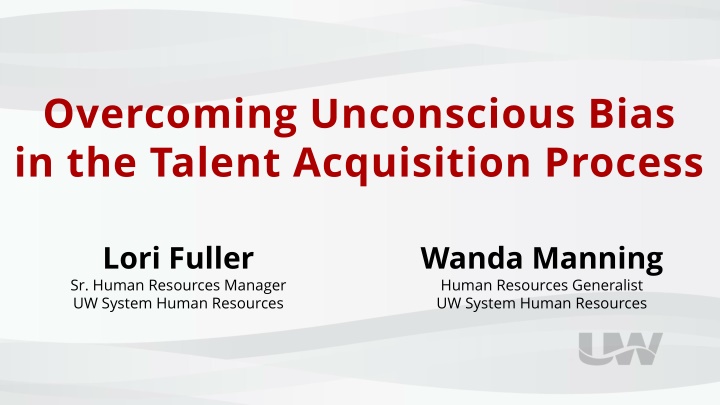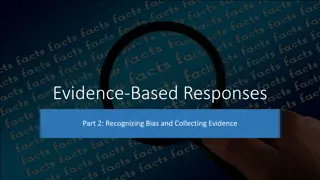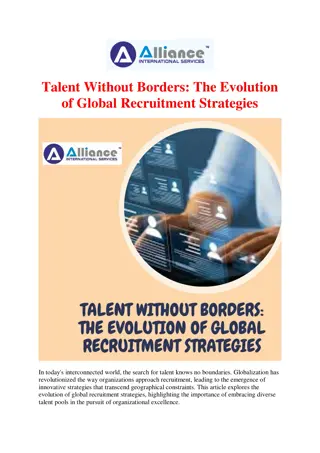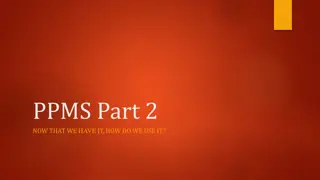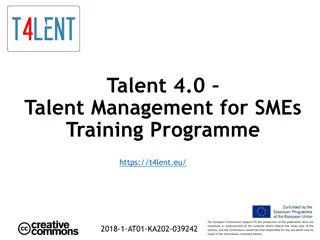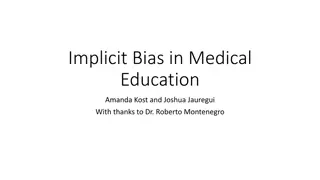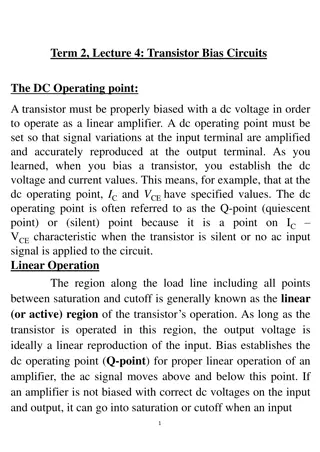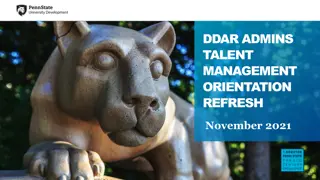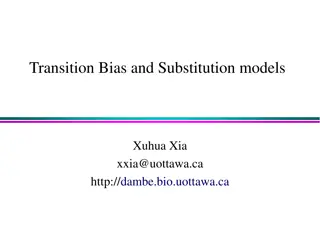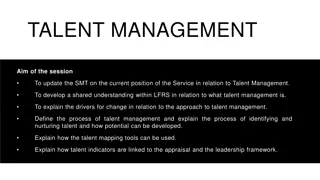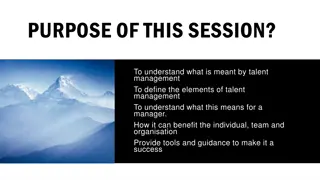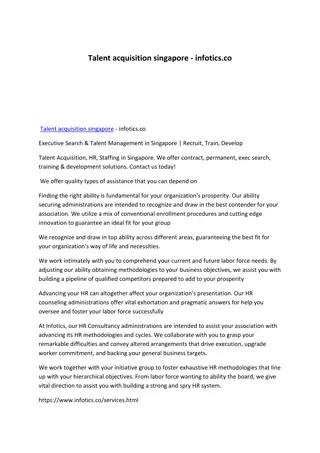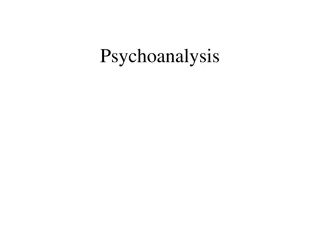Overcoming Unconscious Bias in Talent Acquisition Process
Overcoming Unconscious Bias in Talent Acquisition Process emphasizes the importance of addressing unconscious bias in hiring practices through awareness and control. The content delves into defining unconscious bias, its impact on diversity, examples, and strategies for managing bias. The University of Wisconsin System's commitment to inclusive excellence and the significance of preventing discrimination are highlighted. The role of the brain in processing information and making decisions is explored, shedding light on how biases manifest. The concept of unconscious bias in hiring is unravelled through thought-provoking scenarios, urging readers to challenge their own biases.
Download Presentation

Please find below an Image/Link to download the presentation.
The content on the website is provided AS IS for your information and personal use only. It may not be sold, licensed, or shared on other websites without obtaining consent from the author.If you encounter any issues during the download, it is possible that the publisher has removed the file from their server.
You are allowed to download the files provided on this website for personal or commercial use, subject to the condition that they are used lawfully. All files are the property of their respective owners.
The content on the website is provided AS IS for your information and personal use only. It may not be sold, licensed, or shared on other websites without obtaining consent from the author.
E N D
Presentation Transcript
Overcoming Unconscious Bias in the Talent Acquisition Process Lori Fuller Sr. Human Resources Manager UW System Human Resources Wanda Manning Human Resources Generalist UW System Human Resources
Overview UWSA s Commitment to Inclusive Excellence What is Unconscious Bias? Types of Unconscious Bias Impact of Diversity Examples of Unconscious Bias Controlling Unconscious Bias Discussion
The University of Wisconsin System is an affirmative action/equal opportunity employer and actively seeks and encourages applications from women, minorities, and persons with disabilities. REGENT POLICY 17-4 It is the policy of the University of Wisconsin System to adopt and support measures designed to prevent and eliminate discrimination against employees and prospective employees of the University of Wisconsin System on the basis of race, color, religion, sex, gender identity or expression, national origin, age, or physical handicap.
The Brain is Amazing It can process vastly more information than the conscious mind by using shortcuts based on our background, cultural environment, and personal experiences to make instantaneous decisions about everything around us. Automatic reactions and skills Implicit knowledge Instinct and intuition The Royal Society (2015, November 17). Understanding Unconscious Bias [Video file]. Retrieved from https://youtu.be/dVp9Z5k0dEE
Equalityandinclusion (2015, September 17). What is Unconscious Bias? [Video File]. Retrieved from: https://youtu.be/rbe5D3Yh43o
WHAT IS BIAS IN HIRING PRACTICES? Tendencies to favor or prefer one person or group over another person or group for reasons unrelated to the actual job criteria. WE DON T SEE THINGS AS THEY ARE, WE SEE THINGS AS WE ARE. ~Anais Nin WHAT IS UNCONSCIOUS BIAS? Unconscious bias is a mental shortcut and results from almost automatic connections or decisions we make often without conscious consideration.
We all have We all have unconscious bias. unconscious bias.
The Father-Son Activity SOLVE THE FOLLOWING PROBLEM: A father and son were involved in a car accident in which the father was killed and the son was seriously injured. The father was pronounced dead at the scene of the accident and his body was taken to a local morgue. The son was taken by ambulance to a nearby hospital and was immediately wheeled into an emergency operating room. A surgeon was called. Upon arrival and seeing the patient, the attending surgeon exclaimed Oh my God, it s my son! Explain how this can happen. Pendry, Driscoll, & Field (2007).
As Humans, Our Tendency Is To Prefer To Be With People Who: Look like us Sound like us Share our social background Interests Education We are naturally drawn to people who have commonalities with us. We find comfort in what we know regardless of whether or not we believe this to be the right choice. This can manifest in a bias recruitment process and we can let the real talent slip through our fingers. IncrediblePeopleAUS (2016, September 21). Unconscious Bias in Recruiting [Video file]. Retrieved from https://youtu.be/C-Dp372Jsj4
Types of Unconscious Bias CONFIRMATION BIAS Involves favoring information that confirms previously existing beliefs or biases. For example, a hiring manager has a preference for hiring candidates who have graduated from a specific college or university. ANCHORING BIAS Over-relying on the first piece of information obtained and using it as the baseline for comparison. For example, if the first applicant has an unusually high test score, it might set the bar higher than applicants with more normal scores. HALO/HORN EFFECT HALO: The tendency to judge others similarly on all traits, assuming that because someone is good or bad at one thing they will be equally good or bad at another. For example, during a search, if a candidate has strong education credentials the committee might conclude that he/she is also a strong leader. HORN: The concept by which a person who is judged negatively on one aspect is automatically judged negatively on several other aspects without much evidence. Clearly, this is the opposite of the halo effect. IN-GROUP BIAS Makes us more comfortable with those who we unconsciously feel are like us and in our group. For example, search committee members who perceive commonalities with applicants are more likely to view them favorably. STEREOTYPE BIAS Attributing assumed or learned characteristics of a group to individual members of the group, whether or not they share the characteristic. For example, a search committee member judges a job candidate by their physical appearance.
Workplaces with Greater Diversity Report Greater: Adaptability Productivity Profitability More effective execution of strategy due to the broader variety of viewpoints and strengths that comes from the workforce IncrediblePeopleAUS (2016, September 21). Unconscious Bias in Recruiting [Video file]. Retrieved from https://youtu.be/C-Dp372Jsj4
Examples of Unconscious Bias Candidate address long commute or lives in an undesirable location Email address crazymom666 The university attended Social networks stated political affiliations or religious affiliations Phone interviews tone, pitch, or accent Appearance clothes, hair style, tattoos Gaps in employment justified or a red flag? Tolstoi-Miller, Gail (2017, May 4). Unconscious Bias: Stereotypical Hiring Practices [Video file]. Retrieved from https://youtu.be/QCFb4BiDDcE
Potential Blind Spots (Bias) in Candidate Selection TESTING INTERVIEWING REFERENCES PANEL INTERVIEW RIGHT FIT- COMFORT Method Used Fairness Languages Predictive Bias Measurement Bias First Impression Negative Emphasis Halo/Horn Effect Cultural Noise Contract Effect Confirmation Bias Gender Implications Bias in Self- Identification Functional Bias Panel Member Selection Documentation Observation / Analysts Cultural / Gender Biases Expectation of Assimilation Subjective Vs. Objective Criteria Standardization Introspection
Tips to control for Unconscious Bias Replace your self-image as an objective person with recognition and acceptance that you are subject to the influence of bias and assumptions Insist on a diverse search committee Increase the representation of women and minorities in the applicant pool Develop well-defined, objective evaluation criteria prior to reviewing applications Prioritize evaluation criteria prior to evaluating applicants Check yourself and each other in counter-stereotype imaging to reduce the influence of unconscious assumptions (i.e. imagine an astronaut, engineer, CEO who is also a woman) Spend sufficient time evaluating each applicant; minimize distractions
Media Partners [2017, September 12]. How to Overcome Unconscious Bias [Video file]. Retrieved from: https://youtu.be/vytOEbWvVjc
We cant cure We can t cure unconscious bias, unconscious bias, but with self but with self- - awareness we can awareness we can address it. address it. The Royal Society (2015, November 17). Understanding Unconscious Bias [Video file]. Retrieved from https://youtu.be/dVp9Z5k0dEE
Discussion Be honest with yourself. It s okay to have biases we all do. It doesn t make you any less of a person. What s important is that you control them and actively look for ways to expand and revise your views. Be open to change. Recognize how your assumptions can influence your decisions and make a conscientious effort to overcome your assumptions. Change your outlook to prevent bias. Everyone should aim to assess others more positively to give credit where it s due and not magnify shortcomings.
Summary Everyone has Biases Recognize your Biases Question what you Think you Know Change your Viewpoint Understand how your Biases Affect your Decision-Making Focus on what is Important
Resources Project Implicit: https://implicit.harvard.edu/implicit/selectatest.html Project Implicit Test: https://implicit.harvard.edu/implicit/takeatest.html KIRWAN INSTITITE: http://kirwaninstitute.osu.edu/researchandstrategicinitiatives/implicit-bias-review/ Emtrain (2016, May 19) What is Unconscious Bias? [Video File]. Retrieved from: https://youtu.be/R95bU9Z7afQ Marshall E-Learning Consultancy (2017, May 12). How We Make Decisions and How Unconscious Bias Affects Judgement [Video File]. Retrieved from: https://youtu.be/dlwkvB0Diz4 Equalityandinclusion (2015, September 17). What is Unconscious Bias? [Video File]. Retrieved from: https://youtu.be/rbe5D3Yh43o Litmos Heroes ( 2016, October 28). Unconscious Bias Leadership and Management [Video File]. Retrieved from: https://youtu.be/dloCJq8shZE PwC (2017, June 23). Blind Spots: Challenge Assumptions [Video File] Retrieved from: https://youtu.be/BFcjfqmVah8 Media Partners (2017, September 13). Unconscious Bias Test [Video file]. Retrieved from https://youtu.be/0veDFGo666s Ali al-Yunani (2015, December 9). What Muslims Are Hiding From You. [Video file]. Retrieved from: https://youtu.be/OiKZpsu418k Media Partners [2017, September 12]. How to Overcome Unconscious Bias [Video file]. Retrieved from: https://youtu.be/vytOEbWvVjc The Royal Society (2015, November 17). Understanding Unconscious Bias [Video file]. Retrieved from https://youtu.be/dVp9Z5k0dEE Grovo.com. Addressing Unconscious Bias with Modern Learning, Overcome Your Unconscious Bias. [Video File]. Retrieved from: https://www.grovo.com/lessons/overcome-your-unconscious-bias TV 2 Denmark (2017, January 27). All That We Share [Video file]. Retrieved from: https://youtu.be/jD8tjhVO1Tc
